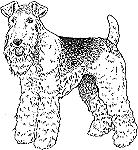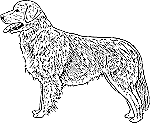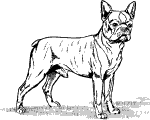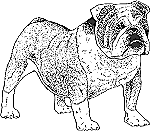 | |
Deaf Dog Education Action Fund |
| Home | | | FAQs | | | | | Resources | | | Rescue | | | You Can Help |
Training Tips
In order to really enjoy a dog, one doesn't merely train him to be semi-human. The point of it is to open oneself to the possibilty of becoming part dog.
- Edward Hoagland
- Introduction
- Special Considerations For Owners of Deaf Dogs
- Learning A New Language
- To Leash, Or Not To Leash
- Desensitization Exercises to Reduce Startling
- Getting The Deaf Dog's Attention When He's Not Looking At You
- Keeping The Deaf Dog Informed Of Your Whereabouts
- Not For The Lazy
Introduction
 These training tips are taken, with permission, from Susan Cope Becker's book Living With A Deaf Dog which is a must for new deaf dog owners. You can order a copy of the book through the link on our website.
These training tips are taken, with permission, from Susan Cope Becker's book Living With A Deaf Dog which is a must for new deaf dog owners. You can order a copy of the book through the link on our website.
We bought our Boston Terrier in December of 1995. She had our hearts immediately....and when we discovered she was deaf, there was no way we could destroy her. I searched and searched for a book on training deaf dogs, and when I didn't find one, I turned to the Internet and also found a local trainer who was willing to work with us. The results have been tremendous! Spanky is a regular dog who knows almost twenty signs. She lives a pretty normal life except for always being on a leash.
 Training a deaf dog requires a major commitment and lots of patience. I can't stress the importance of an American Sign Language pocketbook. It will open up a world of words for you and your dog. Spanky's vocabulary increased as ours did. Your deaf dog is going to surprise you. All that's happening is that she is learning signs (and facial expressions) instead of words. I will also add that the first word signs you should concentrate on are sit, down, stay, come, no and stop. When you dog understands these words, begin adding a new one occasionally...car, walk, etc. The first six are enough to begin with.
Training a deaf dog requires a major commitment and lots of patience. I can't stress the importance of an American Sign Language pocketbook. It will open up a world of words for you and your dog. Spanky's vocabulary increased as ours did. Your deaf dog is going to surprise you. All that's happening is that she is learning signs (and facial expressions) instead of words. I will also add that the first word signs you should concentrate on are sit, down, stay, come, no and stop. When you dog understands these words, begin adding a new one occasionally...car, walk, etc. The first six are enough to begin with.- Keep your dog on a leash when walking. The leash, and a fenced yard or stake and lead are necessities with the deaf dog. Buy a dog tag stating, "(dog's name) is deaf. Please hold and call (your name/phone)". Put a bell on your dog. Hunting dog bells are good, but if you think too bulky, use one of those loud Christmas bells women wear as necklaces during the holidays. This allows you to hear your dog when he is on the move. Good luck when he falls asleep somewhere out of the way and you can't find him.
- To get your dog's attention, thump on the floor with your fist or foot or wave. Some people use a flashlight or a laser light (Radio Shack). If your dog is outside at night and you want to call him in, turn your porch light off and on.
 Find a trainer that will take you in a basic obedience class. Use standard obedience signs and American Sign Language (a pocket-sized book version is inexpensive and invaluable). As you speak the commands (your dog will also watch your face and you will have more expression if you are speaking). This should get you to sit, lay, stay, and come. Give the sign and put your dog in the position you want him to be. Reward with food. Repeat. Training sessions should last about 15 minutes. Train a deaf dog just like a hearing dog (except for signing instead of speaking).
Find a trainer that will take you in a basic obedience class. Use standard obedience signs and American Sign Language (a pocket-sized book version is inexpensive and invaluable). As you speak the commands (your dog will also watch your face and you will have more expression if you are speaking). This should get you to sit, lay, stay, and come. Give the sign and put your dog in the position you want him to be. Reward with food. Repeat. Training sessions should last about 15 minutes. Train a deaf dog just like a hearing dog (except for signing instead of speaking).- From there you will be able to train and teach him as many signs as you want. Some deaf dogs that are 5 or 6 years old know up to 50 signs! Spanky knows the difference between toy and ball. Car and walk are her favorite signs. She knows almost 20 signs at one-year-old...so stay with it. They learn so fast.
- IMPORTANT! When waking him, do it by always touching him GENTLY in the same place. Shoulder is the best. Or put your hand in front of his nose and let your smell wake him. Give him a treat and/or lots of love every time you wake him. Startling the deaf dog out of sleep is usually the touchiest area. The treat will make waking up less traumatic and he will take eager instead of angry. Tell visitors not to touch your dog if he is sleeping, especially children.
 Food rewards are the best way we can reward the deaf puppy since they cannot hear the tone of our voice. (You can taper off the food rewards, as your dog grows older and reward with lots of loving and enthusiasm. The sign for good job is clapping your hands. Some people use a thumbs up.) Carrots (!) are healthy treats, begging strips, dog jerky...
Food rewards are the best way we can reward the deaf puppy since they cannot hear the tone of our voice. (You can taper off the food rewards, as your dog grows older and reward with lots of loving and enthusiasm. The sign for good job is clapping your hands. Some people use a thumbs up.) Carrots (!) are healthy treats, begging strips, dog jerky...- The easiest seen by the dog and the easiest to learn for you for the word "good" is to clap your hands. In ASL, this means good job, success. Smile when you do it. Do it often.
- Leash and fence are a must.
- There are so many training tips to share, but these are probably the most basic. For specific training answers, post specific questions on the Deaf Dogs list. You'll receive more replies than you'll know what to do with! Good Luck. Be patient and loving. Your dog will do the rest.
Special Considerations For Owners of Deaf Dogs
The rest of these tips are based on the original text by Leslie Judkins
Although the decision to adopt any dog is a serious, 10-15 year commitment, not everyone is up to the challenging of owing a deaf dog. This section discusses the special issues you should consider when making your decision.
Return to indexLearning A New Language
 If you are going to live with a deaf dog, you will have to learn a new way to communicate with that dog. You will have to tune into the world of movement, vibration and light. You must use some type of sign language system, either American Sign Language or signs you invent yourself. It will seem strange at first, but both you and your dog will adapt quickly. All that's required is a willingness to learn. (For more information on hand signs and training your deaf dog, see our Signs page.)
If you are going to live with a deaf dog, you will have to learn a new way to communicate with that dog. You will have to tune into the world of movement, vibration and light. You must use some type of sign language system, either American Sign Language or signs you invent yourself. It will seem strange at first, but both you and your dog will adapt quickly. All that's required is a willingness to learn. (For more information on hand signs and training your deaf dog, see our Signs page.)
To Leash, Or Not To Leash
As a general rule of thumb, it is not a good idea to allow a deaf dog off leash in an unenclosed area. This includes such things as walks, playtime at the park, or having your dog accompany you anywhere outside your home. Some people have a difficult time accepting this limitation.
 There are a small number of deaf dog owners who do allow their dogs off leash. Generally, these dogs live in rural areas, are past their adolescent phase, and are trained to the point that their owners feel confident that the dog will "check in," and come when called.
There are a small number of deaf dog owners who do allow their dogs off leash. Generally, these dogs live in rural areas, are past their adolescent phase, and are trained to the point that their owners feel confident that the dog will "check in," and come when called.
This doesn't mean that deaf dogs live their lives on the end of a leash. Obviously, they are free to roam in the house or enclosed yard. Many owners exercise their dogs at a park by using a 30-50 foot web leash, or a flexi-leash. This allows the dog to run and play, but still gives the owner control over the dog.
Return to indexDesensitization Exercises to Reduce Startling
These exercises are nothing more than training your dog how to handle, and respond to, various situations. They are no different than teaching a dog to sit. Your dog's personality will determine how much time you need to spend on these exercises. Some dogs are easy-going and fairly unflappable. Others are more sensitive, and will require more work.
To desensitize a deaf dog to the startle effect of being touched unexpectedly, begin by walking up behind the dog when he isn't looking. Gently touch the dog, then immediately pop a treat in the dog's mouth when he turns around. The dog quickly associates good things (i.e., the treat) with being touched unexpectedly, and learns to respond happily.
 To condition your deaf dog to wake easily in response to a gentle touch, start by first placing your hand in front of the sleeping dog's nose, allowing him to smell that you are near. Next lightly touch the dog on the shoulder or back, pretend you are trying to touch only one or two hairs with your fingertips. Then gently stroke the dog with two fingertips, then with your entire hand. Most deaf dogs will awaken during some part of this exercise. When they open their eyes, their owner's smiling face, and perhaps even a treat rewards them. In a matter of weeks, the dog becomes accustomed to waking up when the owner places a hand in front of his nose, or lightly touches his shoulder or back. Waking up becomes a gentle, positive experience.
To condition your deaf dog to wake easily in response to a gentle touch, start by first placing your hand in front of the sleeping dog's nose, allowing him to smell that you are near. Next lightly touch the dog on the shoulder or back, pretend you are trying to touch only one or two hairs with your fingertips. Then gently stroke the dog with two fingertips, then with your entire hand. Most deaf dogs will awaken during some part of this exercise. When they open their eyes, their owner's smiling face, and perhaps even a treat rewards them. In a matter of weeks, the dog becomes accustomed to waking up when the owner places a hand in front of his nose, or lightly touches his shoulder or back. Waking up becomes a gentle, positive experience.
As a deaf dog matures, he gains self-confidence and experience in a wide variety of situations. With many dogs, the likelihood of being startled generally decreases with age.
Return to indexGetting The Deaf Dog's Attention When He's Not Looking At You
If your dog is facing away from you, one of the simplest things to do is to wait until he turns around. Indoors, if you walk up behind your dog, he may feel the vibrations of your approach and turn around. If not, you can try blowing on the dog's back or head. Or you can touch him lightly.
If the dog is across a room, try stomping your foot on the floor. He may feel the vibrations and turn around. You can also waive your arms and try to attract his attention, or turn a light switch on and off.
 Outdoors during daytime, you can also try tossing a small stone or ball near your dog to get his attention. Be very careful not to hit your dog! Outdoors at night you can attract your dog's attention by flipping a porch or garage light on and off. Or use a flashlight or laser pointer.
Outdoors during daytime, you can also try tossing a small stone or ball near your dog to get his attention. Be very careful not to hit your dog! Outdoors at night you can attract your dog's attention by flipping a porch or garage light on and off. Or use a flashlight or laser pointer.
You can also use a vibrating collar to get your dog's attention. There are several vibrating collars currently being made (and hopefully more to come). We also have directions for their use.
As these examples show, there are numerous methods you can use to attract a deaf dog's attention. All that you need is a little creativity!
Return to indexKeeping The Deaf Dog Informed Of Your Whereabouts
 As you move around your house, or when you leave, be sure to let your deaf dog know what you are doing. If a deaf dog wakes up, or turns around and finds you gone, they can become anxious. Many deaf dogs will search from room to room until they find their "missing" owner.
As you move around your house, or when you leave, be sure to let your deaf dog know what you are doing. If a deaf dog wakes up, or turns around and finds you gone, they can become anxious. Many deaf dogs will search from room to room until they find their "missing" owner.
If a deaf dog is not looking in your direction as you leave a room, get the dog's attention and allow him to watch you leave. He may or may not decide to join you, but at least he will know where you went.
If the dog has been sleeping while you work in a room, you can awaken him with a light touch, or by lightly brushing him with your foot as you leave the room.
Return to indexNot For The Lazy
When supervising and correcting a deaf dog, you will not have the luxury of yelling commands across a yard or room. If your dog is digging in the trash, you will have to get up and walk to the dog to stop his behavior. Granted on some occasions you may be able to get his attention and sign a command. But there will be just as many times when you have no choice but to get up and go to the dog.
Return to indexSee our Signs page for more information on training.
| Home | | | FAQs | | | | | Resources | | | Rescue | | | You Can Help |
© Copyright DDEAF, 1998-2024